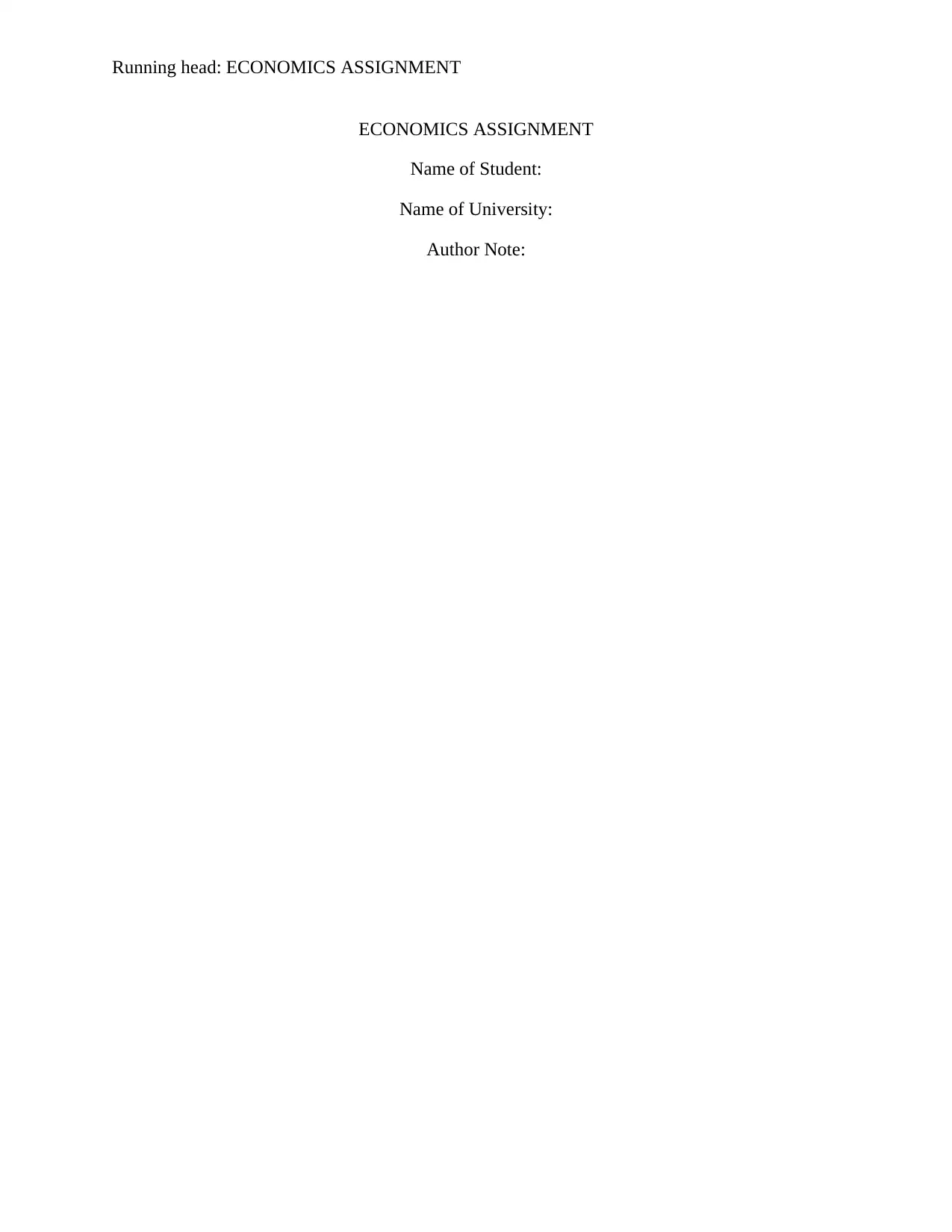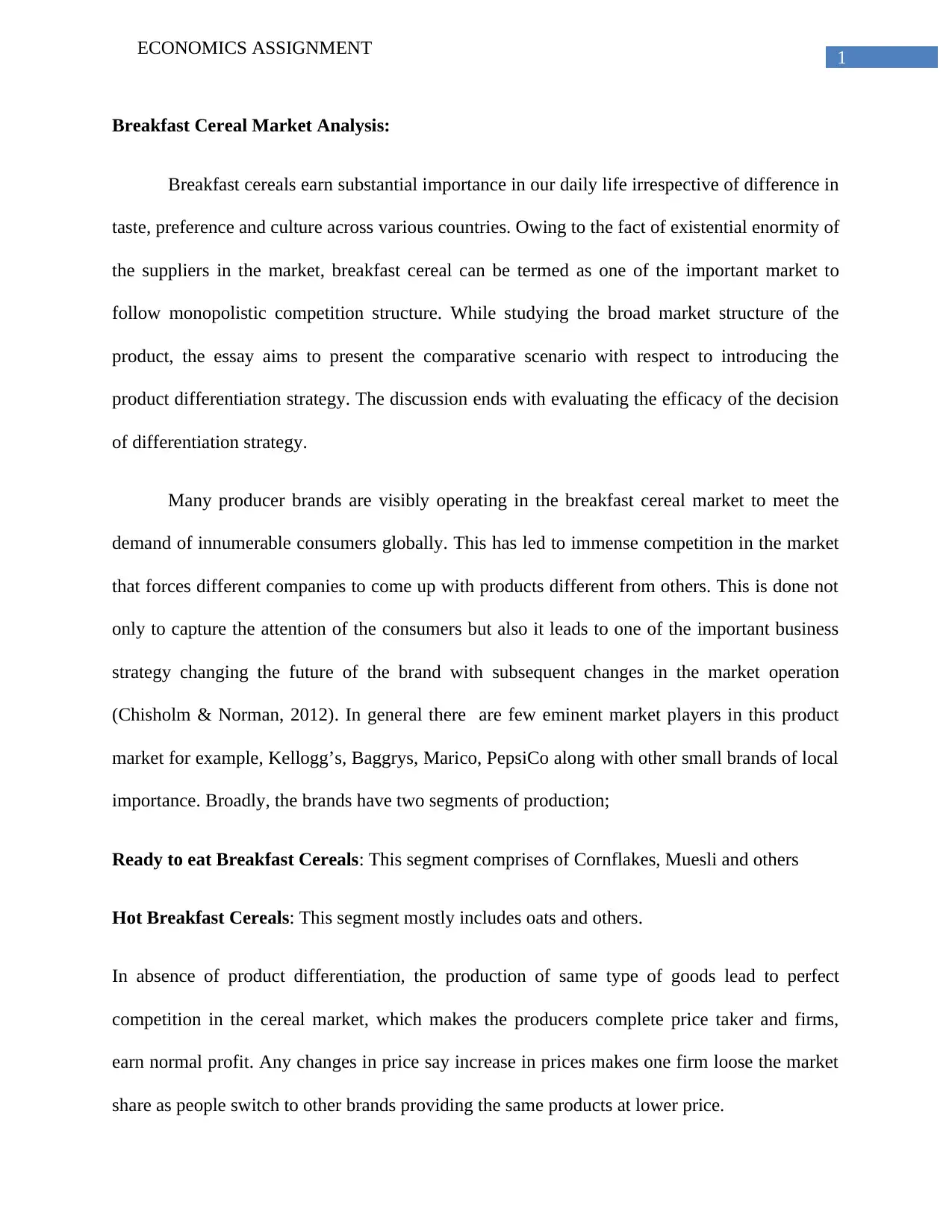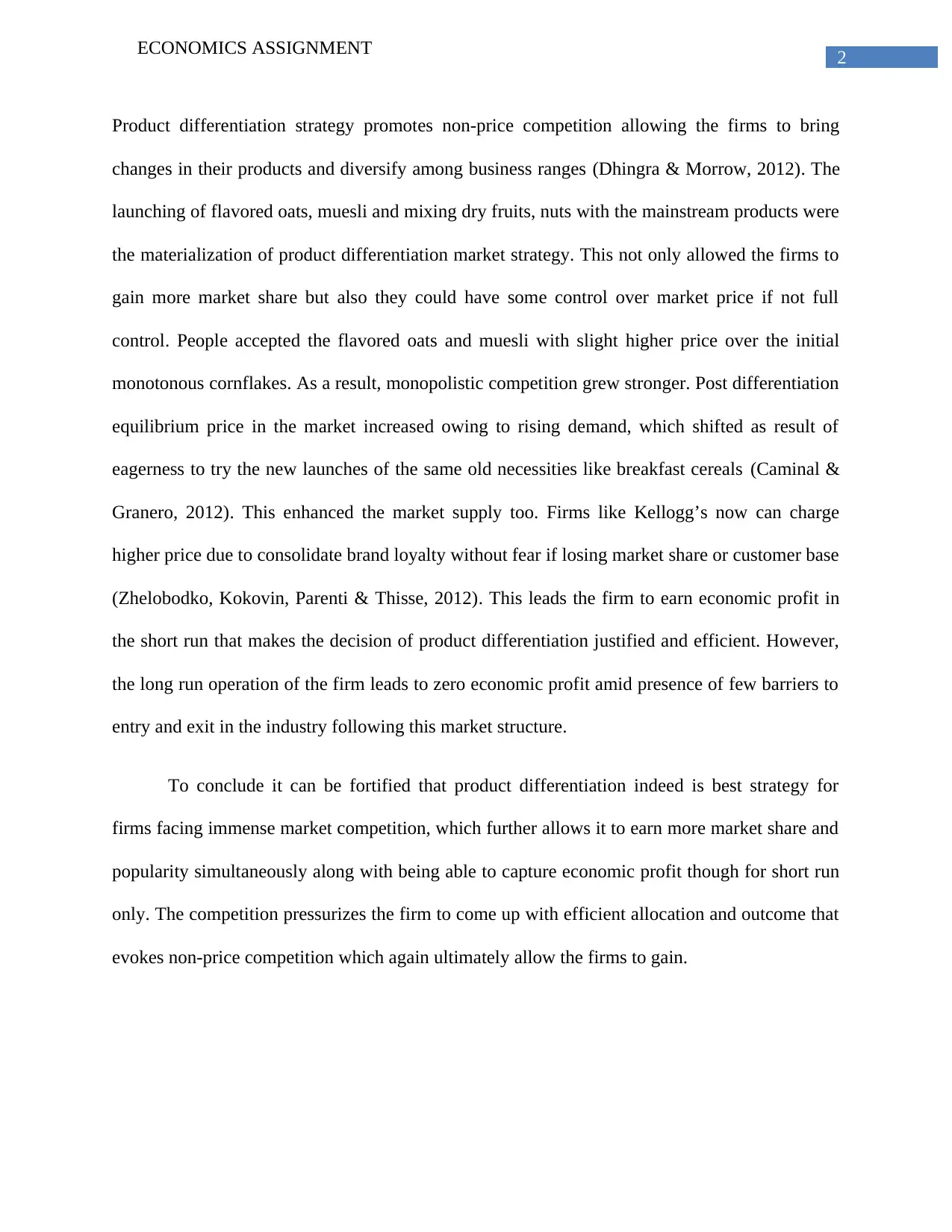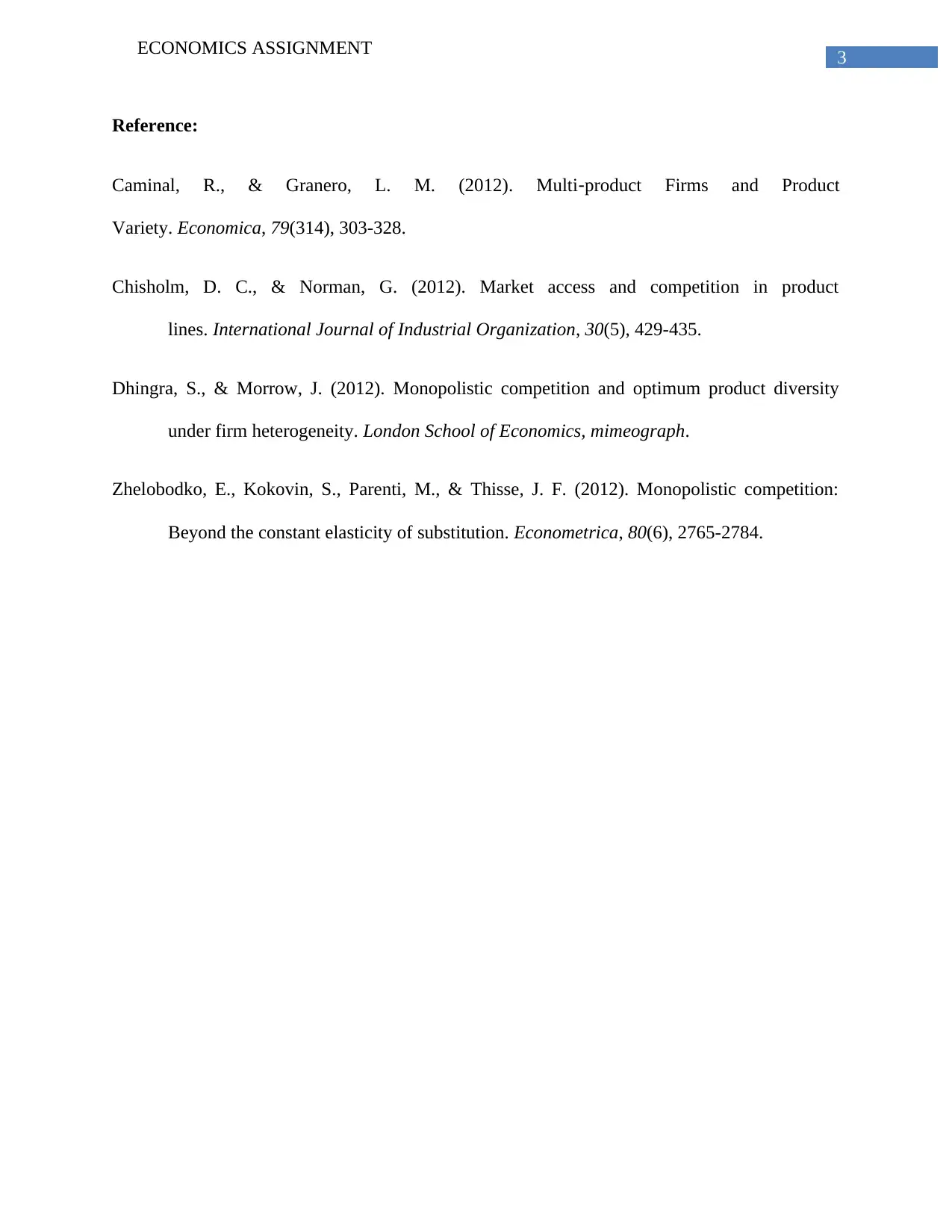Monopolistic Competition in the Breakfast Cereal Market
VerifiedAdded on 2020/04/15
|4
|790
|325
Essay
AI Summary
This economics essay examines the breakfast cereal market, highlighting its monopolistic competition structure and the impact of product differentiation. The analysis explores how brands like Kellogg's compete through product variations, such as flavored oats and muesli, to gain market share and control prices. The essay discusses the shift from perfect competition to monopolistic competition due to these strategies, leading to short-run economic profits. It also considers the long-run implications and concludes that product differentiation is a successful strategy for firms in competitive markets, fostering non-price competition and enhancing market share, although economic profits are limited to the short term. The essay references several academic sources to support its arguments.

Running head: ECONOMICS ASSIGNMENT
ECONOMICS ASSIGNMENT
Name of Student:
Name of University:
Author Note:
ECONOMICS ASSIGNMENT
Name of Student:
Name of University:
Author Note:
Paraphrase This Document
Need a fresh take? Get an instant paraphrase of this document with our AI Paraphraser

1
ECONOMICS ASSIGNMENT
Breakfast Cereal Market Analysis:
Breakfast cereals earn substantial importance in our daily life irrespective of difference in
taste, preference and culture across various countries. Owing to the fact of existential enormity of
the suppliers in the market, breakfast cereal can be termed as one of the important market to
follow monopolistic competition structure. While studying the broad market structure of the
product, the essay aims to present the comparative scenario with respect to introducing the
product differentiation strategy. The discussion ends with evaluating the efficacy of the decision
of differentiation strategy.
Many producer brands are visibly operating in the breakfast cereal market to meet the
demand of innumerable consumers globally. This has led to immense competition in the market
that forces different companies to come up with products different from others. This is done not
only to capture the attention of the consumers but also it leads to one of the important business
strategy changing the future of the brand with subsequent changes in the market operation
(Chisholm & Norman, 2012). In general there are few eminent market players in this product
market for example, Kellogg’s, Baggrys, Marico, PepsiCo along with other small brands of local
importance. Broadly, the brands have two segments of production;
Ready to eat Breakfast Cereals: This segment comprises of Cornflakes, Muesli and others
Hot Breakfast Cereals: This segment mostly includes oats and others.
In absence of product differentiation, the production of same type of goods lead to perfect
competition in the cereal market, which makes the producers complete price taker and firms,
earn normal profit. Any changes in price say increase in prices makes one firm loose the market
share as people switch to other brands providing the same products at lower price.
ECONOMICS ASSIGNMENT
Breakfast Cereal Market Analysis:
Breakfast cereals earn substantial importance in our daily life irrespective of difference in
taste, preference and culture across various countries. Owing to the fact of existential enormity of
the suppliers in the market, breakfast cereal can be termed as one of the important market to
follow monopolistic competition structure. While studying the broad market structure of the
product, the essay aims to present the comparative scenario with respect to introducing the
product differentiation strategy. The discussion ends with evaluating the efficacy of the decision
of differentiation strategy.
Many producer brands are visibly operating in the breakfast cereal market to meet the
demand of innumerable consumers globally. This has led to immense competition in the market
that forces different companies to come up with products different from others. This is done not
only to capture the attention of the consumers but also it leads to one of the important business
strategy changing the future of the brand with subsequent changes in the market operation
(Chisholm & Norman, 2012). In general there are few eminent market players in this product
market for example, Kellogg’s, Baggrys, Marico, PepsiCo along with other small brands of local
importance. Broadly, the brands have two segments of production;
Ready to eat Breakfast Cereals: This segment comprises of Cornflakes, Muesli and others
Hot Breakfast Cereals: This segment mostly includes oats and others.
In absence of product differentiation, the production of same type of goods lead to perfect
competition in the cereal market, which makes the producers complete price taker and firms,
earn normal profit. Any changes in price say increase in prices makes one firm loose the market
share as people switch to other brands providing the same products at lower price.

2
ECONOMICS ASSIGNMENT
Product differentiation strategy promotes non-price competition allowing the firms to bring
changes in their products and diversify among business ranges (Dhingra & Morrow, 2012). The
launching of flavored oats, muesli and mixing dry fruits, nuts with the mainstream products were
the materialization of product differentiation market strategy. This not only allowed the firms to
gain more market share but also they could have some control over market price if not full
control. People accepted the flavored oats and muesli with slight higher price over the initial
monotonous cornflakes. As a result, monopolistic competition grew stronger. Post differentiation
equilibrium price in the market increased owing to rising demand, which shifted as result of
eagerness to try the new launches of the same old necessities like breakfast cereals (Caminal &
Granero, 2012). This enhanced the market supply too. Firms like Kellogg’s now can charge
higher price due to consolidate brand loyalty without fear if losing market share or customer base
(Zhelobodko, Kokovin, Parenti & Thisse, 2012). This leads the firm to earn economic profit in
the short run that makes the decision of product differentiation justified and efficient. However,
the long run operation of the firm leads to zero economic profit amid presence of few barriers to
entry and exit in the industry following this market structure.
To conclude it can be fortified that product differentiation indeed is best strategy for
firms facing immense market competition, which further allows it to earn more market share and
popularity simultaneously along with being able to capture economic profit though for short run
only. The competition pressurizes the firm to come up with efficient allocation and outcome that
evokes non-price competition which again ultimately allow the firms to gain.
ECONOMICS ASSIGNMENT
Product differentiation strategy promotes non-price competition allowing the firms to bring
changes in their products and diversify among business ranges (Dhingra & Morrow, 2012). The
launching of flavored oats, muesli and mixing dry fruits, nuts with the mainstream products were
the materialization of product differentiation market strategy. This not only allowed the firms to
gain more market share but also they could have some control over market price if not full
control. People accepted the flavored oats and muesli with slight higher price over the initial
monotonous cornflakes. As a result, monopolistic competition grew stronger. Post differentiation
equilibrium price in the market increased owing to rising demand, which shifted as result of
eagerness to try the new launches of the same old necessities like breakfast cereals (Caminal &
Granero, 2012). This enhanced the market supply too. Firms like Kellogg’s now can charge
higher price due to consolidate brand loyalty without fear if losing market share or customer base
(Zhelobodko, Kokovin, Parenti & Thisse, 2012). This leads the firm to earn economic profit in
the short run that makes the decision of product differentiation justified and efficient. However,
the long run operation of the firm leads to zero economic profit amid presence of few barriers to
entry and exit in the industry following this market structure.
To conclude it can be fortified that product differentiation indeed is best strategy for
firms facing immense market competition, which further allows it to earn more market share and
popularity simultaneously along with being able to capture economic profit though for short run
only. The competition pressurizes the firm to come up with efficient allocation and outcome that
evokes non-price competition which again ultimately allow the firms to gain.
⊘ This is a preview!⊘
Do you want full access?
Subscribe today to unlock all pages.

Trusted by 1+ million students worldwide

3
ECONOMICS ASSIGNMENT
Reference:
Caminal, R., & Granero, L. M. (2012). Multi‐product Firms and Product
Variety. Economica, 79(314), 303-328.
Chisholm, D. C., & Norman, G. (2012). Market access and competition in product
lines. International Journal of Industrial Organization, 30(5), 429-435.
Dhingra, S., & Morrow, J. (2012). Monopolistic competition and optimum product diversity
under firm heterogeneity. London School of Economics, mimeograph.
Zhelobodko, E., Kokovin, S., Parenti, M., & Thisse, J. F. (2012). Monopolistic competition:
Beyond the constant elasticity of substitution. Econometrica, 80(6), 2765-2784.
ECONOMICS ASSIGNMENT
Reference:
Caminal, R., & Granero, L. M. (2012). Multi‐product Firms and Product
Variety. Economica, 79(314), 303-328.
Chisholm, D. C., & Norman, G. (2012). Market access and competition in product
lines. International Journal of Industrial Organization, 30(5), 429-435.
Dhingra, S., & Morrow, J. (2012). Monopolistic competition and optimum product diversity
under firm heterogeneity. London School of Economics, mimeograph.
Zhelobodko, E., Kokovin, S., Parenti, M., & Thisse, J. F. (2012). Monopolistic competition:
Beyond the constant elasticity of substitution. Econometrica, 80(6), 2765-2784.
1 out of 4
Related Documents
Your All-in-One AI-Powered Toolkit for Academic Success.
+13062052269
info@desklib.com
Available 24*7 on WhatsApp / Email
![[object Object]](/_next/static/media/star-bottom.7253800d.svg)
Unlock your academic potential
Copyright © 2020–2025 A2Z Services. All Rights Reserved. Developed and managed by ZUCOL.





